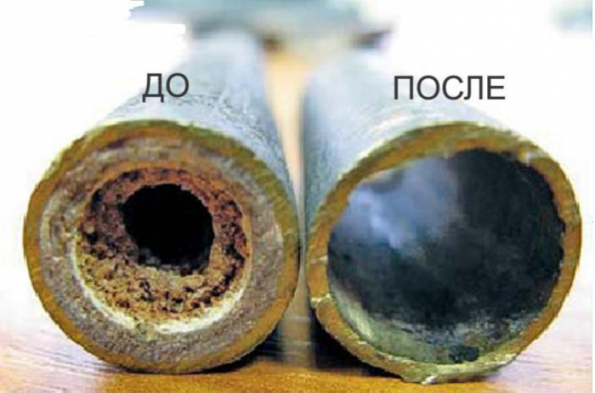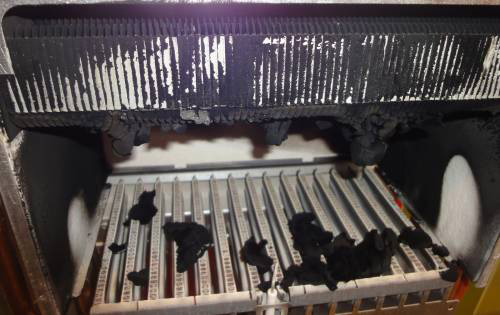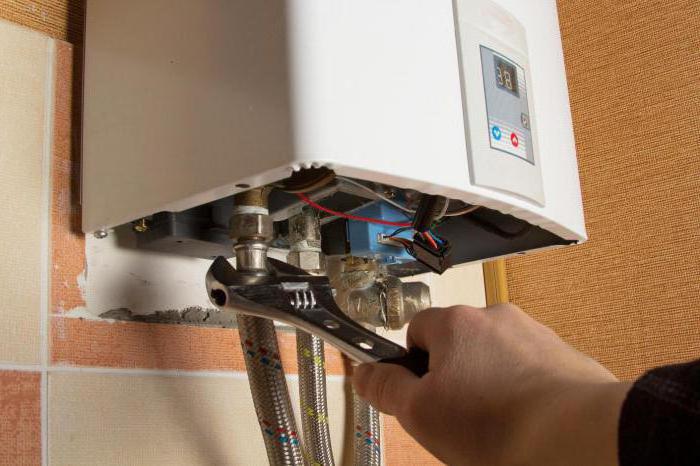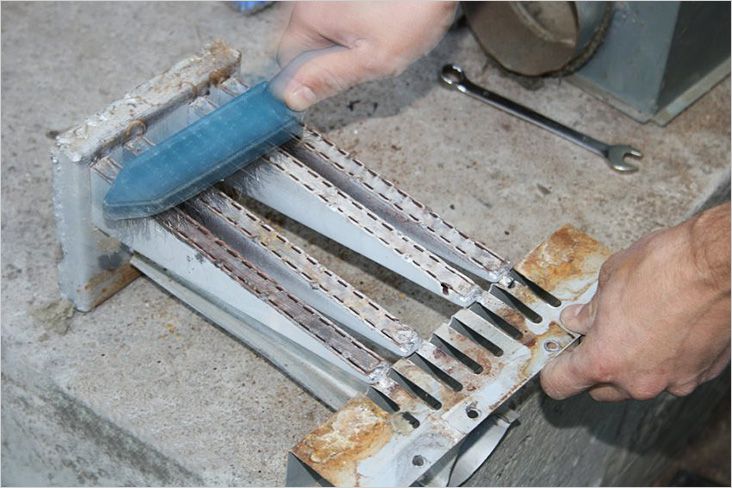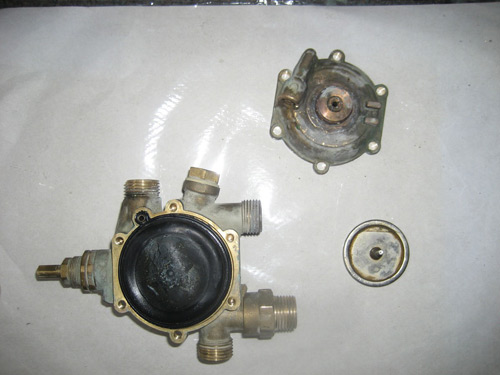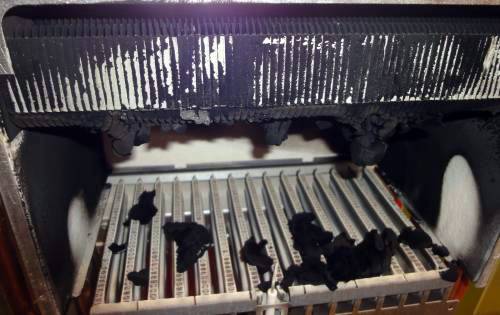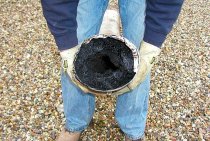Scale prevention
Regular cleaning of the gas column will extend its life. It will help to avoid breakdowns inside the system, increase its efficiency, avoid the smell of burning and the appearance of soot in the room.
Preventive measures:
- Checking the performance of equipment, how the fuse occurs, water temperature, heating rate, etc.
- External examination of the surface of the structure to detect scale, grease.
- Inspection of the condition of the radiator, checking traction, ignition.
After carrying out preventive work, the degree of contamination of the structure is assessed, measures are taken to eliminate scale and grease.
To extend the life of the circulation pump, it is recommended to install a mesh on the suction pipe, which will trap the dissolved scale, preventing it from entering the radiator.
When cleaning the device, it is important to act carefully, having previously studied the instructions for the device and turning off the gas flow. In the event of a gas leak, urgently call 104 to protect the premises from fire
comments powered by HyperComments
Descaling
To wash the heat exchanger, which is completely dismantled from the gas column, it is necessary to prepare a special detergent. There are several options here:
- funds available for sale and intended for this purpose;
- citric acid solution (100 grams of powder per 500 ml of water);
- a solution of water with vinegar 9% in proportions of 1:5.
With a solution of vinegar or citric acid, the heat exchanger is filled with a watering can and aged for several hours. The easiest way is to leave the knot to soak overnight. If descaling is carried out with a special tool, then the proportions and exposure time must be observed based on the instructions on the package. At the end, the contaminated solution is drained into the sewer, and the heat exchanger is washed with running water. To do this, you can use a water hose from a shower with an unscrewed nozzle. The process is shown in more detail in the video:
Why the column needs to be cleaned
The function of a geyser is to heat water by burning gas. Thus, the geyser at the same time belongs to two types of rubble appliances at once - gas and water. In the gas part of the column, soot accumulates and deposits form, which must be periodically cleaned out. Also, sometimes you need to clean the jets - the calibrated holes of the burner and igniter.
The main scourge of the water part of the column is scale. Scale is salts dissolved in hard tap water, which precipitate during the evaporation of water and settle on the walls of the water pipes of the column. Scale in the heat exchanger is a particular problem. In order for the water passing over the burner to have time to warm up, in the heat exchanger the water flow is distributed through thin tubes. By clogging the channels of the thin tubes of the heat exchanger, scale can significantly reduce the efficiency of the column, or even make this work completely impossible.
Removing soot from the heat exchanger
The best way to properly service this unit is to completely remove it from the machine. To do this, turn off the water and gas, and then open the hot water tap closest to the flow heater. Then, using an open-end or gas wrench, loosen the union nut securing the pipe to the water unit and unscrew it a couple of turns. The contents of the heat exchanger must flow out through the mixer, it must be left open.
Next, to clean the column, unscrew both union nuts and remove the assembly. First, you will have to disassemble other elements and parts of the unit that prevent the dismantling of the heat exchanger.Their number depends on the design of the column, in one case it will be necessary to remove the chimney diffuser, in the other - the ignition group, in the third - the draft or overheating sensor. You may need to remove all of these parts.
During the dismantling of the heat exchanger, it is recommended to cover the burner nozzles with a rag, otherwise soot will inevitably get there. When the disassembly is completed and the assembly has been successfully removed, cleaning the gas column heat exchanger is not difficult. Feel free to take it to the bath, where with the help of detergents and a long-bristled brush, wash it from soot, and then dry it well. After that, the assembly is installed in place and the heater is assembled in the reverse order. At the same time, do not forget to replace the sealing rings at the junctions of the pipes.
The last operation is a leak test and the unit is put into operation. First, the water supply is opened and the heat exchanger is filled due to the open tap of the mixer. Then the valve is closed and an inspection is made for the permeability of the joints. If everything is in order, the gas valve opens and the column is checked in operating mode.
Signs that you need to clean the column
Faults indicating the need for maintenance of the water heater are obvious
You can independently diagnose, paying attention to the following failures:
- No pressure - reason: the gas column heat exchanger is clogged. Under constant thermal influence, the coil inside is gradually overgrown with scale. A characteristic feature: a significant difference in pressure in the cold water and hot water pipelines.
- Insufficient intensity of water heating - the geyser is clogged with soot. When fuel is burned, some of the combustion products settle on the fins of the heat exchanger. A large amount of soot in the gas column is formed due to several reasons:
- burning with insufficient oxygen;
- gas combustion at low temperature;
- type of fuel (with bottled gas, there are more combustion products than when using main fuel).
Due to disturbances in the combustion process, a large amount of combustion products accumulate on the heat exchanger. Soot has heat-insulating properties. If the surface of the radiator is not cleaned in time, the water will warm up longer and at a lower temperature. It comes to the point that the burner at full power is not able to heat the liquid to the desired parameters.
- The water heater does not start or turns off after 1-2 minutes of operation.
According to the manufacturer's instructions, scheduled maintenance of a flowing gas water heater is necessary at least 1 time in 1-2 years. The frequency of preventive cleaning is affected by the quality of the water used and the presence of protection against scale.
With regard to the maintenance of storage gas water heaters, it is recommended to clean the tank annually. During the repair, the magnesium anode is changed, the condition of the surface is checked and, if necessary, flushing is done, eliminating calcium deposits.
Cleaning the gas column from scale and soot can be done independently. For work, an understanding of the internal structure and design is necessary. A minimum set of plumbing tools is required.
Cleaners
Craftsmen advise using hydrochloric acid to clean the radiator, but this composition causes an additional oxidative reaction upon contact with metal, destroys the surface of aluminum / copper structures.
Folk
Folk remedies no less effectively cope with the task of cleaning the radiator and other parts of the device.
Citric acid is effectively applied (500 ml of liquid per 60 g of product).
- Fill the basin a third with water, put on the stove.
- Place the radiator and pour the solution.
- Warm up the container for about 30 minutes.
- Rinse the unit and other accessories with running water.
Similarly, you can use:
- Vinegar (0.5 l of water per 150 g of acid).
- Soda (pour 200 g of soda into the drain hole, then pour ½ cup of vinegar).
It is not recommended to clean the aluminum heat exchanger with such compositions so as not to damage the walls of the device. In the presence of "heavy" contamination, several procedures will be required using a new portion of the cleaner.
Household chemicals
Professional cleaners are used to remove heavy dirt
It is important to follow the safety rules, follow the instructions for use indicated on the packaging
Safe chemicals for self-cleaning of the unit:
- Neva;
- Electrolux;
- Bosch;
- Oasis;
- Vector;
- AntiNakipin.
Clean the heat exchanger as follows: connect a funnel to the pipe, into which gradually pour the solution. As soon as the pressure increases on the other side of the pipe, the job is done. It remains only to rinse the unit.

Methods for flushing a column with a pump
For regular flushing, you will need a circulation pump with a liquid container, an eyeliner, a rubber hose, a 24 key, citric acid or 0.5 liters of vinegar.
You can install additional equipment to the gas water heater yourself, strictly following the instructions, but it is better to turn to professionals to avoid gas leakage.
There is an easy way to flush the column with a homemade cleaning solution.
Training:
- turn off the gas supply valve;
- pour water into a container, put on heating;
- remove the column cover to access the inside of the instrument.
In this case, flushing is carried out without removing the heat exchanger.
When using additional equipment, the following manipulations must be performed:
- Unscrew the inlet pipe of the water supply regulator to secure the pump.
- Disconnect the flexible hose from the pump.
- Put the regulator back.
- Open a tap with hot water, where dilute citric acid in a ratio of 100 g per liter of boiling water.
Do not use concentrated citric acid, it adversely affects the integrity of copper pipes.
When cleaning the internal components of the geyser, you can use another method:
- Pour the solution into the tank.
- Start the system for flushing the heat exchanger, setting the operating time to two hours.
- Turn on the column igniter to increase efficiency.
- After flushing, reassemble in reverse order.
Before assembly, it is necessary to clean the burner with a brush, sweeping away all residues of combustion products. After carrying out all the manipulations, the column is assembled in the reverse order, fixing all the details in their place.
How to know that it's time to clean the gas column
Gas column cleaning is necessary if:
- The column does not turn on, or turns off after working for a while. At the same time, it is precisely known that gas and water enter the column.
- The column thermal protection sensors are constantly triggered. The scale layer has a porous structure and has heat-insulating properties, which interferes with the normal cooling of the column.
- The efficiency of the column has noticeably decreased: during normal operation of the burner, the water heats up much weaker.
- Weak head at the outlet of the column with a normal head at the inlet. Water cannot get through the channels covered with scale.
Cleaning the water inlet
The water intake unit is installed at the inlet of the water supply system of the column, it has a mesh filter to prevent clogging of the heat exchanger tubes with large particles of rust and sediment, as well as a membrane for automatic gas supply when the water tap is turned on.
- We remove the water intake unit from the column body.
- Having unscrewed the connecting screws, we open the case.
- We clean the filter and rinse it with a strong pressure of water.
- We check the membrane. The membrane should be flat, if the membrane has a pronounced concavity, then it has exhausted its resource and must be replaced. You can replace the "native" membrane of the old column with a modern silicone one, which has a much longer service life.
- We close the cover of the water intake unit, “bait” the screws and tighten the diametrically opposite pairs of screws alternately. Thus, a uniform tension of the membrane is ensured.
Cleaning the heat exchanger
- Disconnect the water inlet and outlet pipes to the heat exchanger. If the heat exchanger is not cleaned regularly, the fastening nuts may be clogged with scale, preventing them from detaching. In this case, we recommend using a special VD-40 fluid, which can be purchased at any car dealership. It is necessary to drip liquid into the junctions of the nuts using an oiler. You can also use "Silit" from scale. After 15-30 minutes, the nuts can be unscrewed. If that doesn't work, try tapping the nut on all sides.
- Having disconnected the heat exchanger, using a funnel, pour the descaling agent into it. As such a tool, a solution of 100 g of citric acid per 0.5 l of hot water is perfect. You can also clean the heat exchanger with nine percent table vinegar, diluted with water in a ratio of one to three. But the use of hydrochloric acid is not recommended, as it can react with the metal from which the heat exchanger is made, which will only aggravate the situation. Leave the solution inside the heat exchanger overnight.
- Drain the solution carefully. If the scale that has left the walls is not removed, it can clog the tubes of the heat exchanger, so we wash the heat exchanger with a strong stream of water from the tap. To do this, you can adapt the tubes of the appropriate diameter.
- We put the washed heat exchanger in place, tighten the fastening nuts, after changing the gaskets.
Soot and soot removal
Unlike the water supply, it is impossible to disassemble the gas part of the column on your own; only a master from the city gas service should do this. The only thing we can do to eliminate soot is to remove carbon deposits from the burner jets.
- The jets are cleaned with thin copper wire.
- The soot is swept away with a metal brush.
- It is advisable to immediately check the column for gas leakage. To do this, it is necessary to prepare a soap solution, which is applied to all joints of gas pipes and units. A gas leak will be indicated by the formation of characteristic bubbles at the junction. If you find a leak, turn off the gas and call 104.
Preventive maintenance can minimize the need for column cleaning. Longer operation of the column without failures and cleanings is facilitated by the use of filters and devices to reduce water hardness.
Cleaning principles
To clean the column from scale, you need to understand the features of the assembly of the device, study the instructions, prepare a cleaning solution, a set of tools for removing screws and tightening valves.
To clean the unit you will need:
- a set of keys;
- screwdrivers;
- rubber hose up to 1 m;
- set of paronite gaskets;
- funnel;
- folk or chemical means for descaling.
In the first element, water is heated, which, when the wick-burner is started, comes from the water supply. The products of combustion exit through the ventilation hole.
Elements must be cleared according to the algorithm:
- heat exchanger;
- plumbing unit;
- jets;
- other constituent components.
The process of removing scale is not difficult, the main thing is to properly tighten the membrane during assembly so that it springs, but does not hang down or be tightly fixed. When cleaning the gas column for the first time, it is recommended to act under the supervision of a specialist.
How often to clean the column
It is necessary to service the geyser at least once every 2-3 months, visually inspecting the surface of the parts. Once every six months, clean the unit using folk remedies or household chemicals.
Do I need to remove and disassemble the column
In order to comprehensively flush the heating device, it is necessary to remove and disassemble it.Open the case, inspect the filter, membrane, radiator, clean using chemistry or folk methods. To reduce the appearance of scale, which will make it less likely to disassemble and clean the entire column, you can flush the radiator once every 2 months without removing it.
Cleaning the heat exchanger without removal
For the procedure you need:
- Disconnect the water supply pipe.
- Put a rubber hose on the outlet pipe.
- Open the tap and drain a small amount of liquid, not more than a liter.
- Use household rust cleaning powder, pre-dilute the mixture with hot water.
- Pour the solution into the pipe in a thin stream. Leave the radiator in this state for 2 hours.
- Open the tap, drain the contents, rinse the structure.
To check it is recommended to use strips of corrugated paper (moving or not). But the fire of a lighter or a candle can be dangerous, especially if there are problems with fuel leakage.
When is it time to clean your gas stove?
The following signs indicate that a gas column needs to be cleaned:
- the main burner is ignited with difficulty, and sometimes with a strong pop;
- the heater starts, but does not work for long, the main burner turns off quickly;
- from below, from under the casing, soot begins to pour;
- the unit operates at maximum power, but the water barely heats up.
Cotton in the combustion chamber indicates that a large amount of gas has time to accumulate in it before ignition. So, the problem is in the igniter, which ignites the fuel with a delay. A visual sign is a weak flame of the wick, colored yellow, this is a sign of a clogged jet. The solution to the problem is to clean the igniter. In most models of columns, the ignition unit can be easily disconnected from the main burner and remove debris from the jet.
The soot accumulated between the heat exchanger fins leads to the operation of overheating and draft sensors. The cross section of the gas-air path decreases significantly, and the water temperature increases. In this case, it is necessary to clean the radiator and the walls of the combustion chamber from soot. The extreme degree of pollution is when soot flakes fall out from under the decorative steel apron, covering the floor or objects under the heater.
Weak heating of running water is a consequence of a decrease in the flow area of the heat exchanger pipes, whose inner walls are covered with a thick layer of scale. A sign of the total "overgrowth" of the internal passage of the tubes is a noticeable decrease in water pressure at the outlet of the column at its normal pressure at the inlet. These are the salts contained in tap water, intensively deposited on the heated surfaces of the pipes and form a strong thick coating. Then the geysers, or rather, heat exchangers, are cleaned of scale by flushing.
How to clean the column from soot
Carbon deposits on the heat exchanger reduce efficiency, and clogged nozzles lead to a failure in the operation of the water heater. To get rid of soot, gas water heaters are serviced at least once every 2 years. During preventive maintenance, the nozzles are cleaned and carbon deposits are removed from the heat exchanger. You can do this in the following way:
- The heat exchanger is washed with an ordinary soapy solution - before starting work, it is recommended to vacuum the radiator and remove carbon deposits and dirt. To wash the soot, use a soft brush with a long pile.
- Carbon deposits are removed from the burner using a special hook - all holes are cleaned with high quality. After maintenance, the gas supply is regulated.
Before turning on the column, the tightness of the threaded connections must be checked. Starting the burner after cleaning is carried out only if there are no gas leaks.
Causes of scale
Soot and scale appear in the gas column mechanism during use. The reason for this is not only the exhaust gas vapor, through which the liquid is heated.But also the use of hard water, which settles on the walls of the pipes, leading to a decrease in the operation of the device.
Signs that indicate clogging of the gas column:
- Fine jet of hot water.
- After turning on the water, the column turns off.
- The device does not turn on.
- The heating of the liquid is reduced.
- The column works sporadically, although the water pressure does not change.
- The device cools down for a long time, protection is constantly triggered.
You can externally assess the condition of the device - look at the awning and visually assess the degree of contamination.

How and how to clean the geyser from scale
There are several ways to remove lime deposits from the inside of the tubes of a heat exchanger or storage tank. To get started, you can use improvised descaling agents or a special cleaning fluid (sold in household chemical stores and building supermarkets). So, you can get rid of a small scale.
If the deposits are of moderate severity, it will not work to flush the heater without the use of specialized equipment. In the best case, it will be possible to reduce the thickness of the deposits.
You can clean the geyser from scale at home with a special washing machine. The pump is filled with professional products that dissolve calcium and lime deposits. Flushing the geyser from scale is carried out under pressure. The device is connected to the outlets of the heat exchanger. At home, with the help of a pump, it will be possible to clean the gas column without disassembling it.
If the above tips do not help, service will be required. Specialized industrial equipment will help to remove scale in a gas water heater.
To clean the coil from scale at home, you can use the following improvised and chemical means:
- Household chemicals and improvised means - washing the gas column with citric acid is effective. Citric acid, a tool that is present in almost every kitchen, will be able to cope with primary deposits. A similar effect has ordinary vinegar, diluted to 7% solution.
After washing the heat exchanger with lemon or vinegar, the pipe cavity is treated with soapy water. Among household chemicals, you can use Silit and any other composition that eliminates calcium and lime deposits.
- Specialized means for flushing geysers from scale - ready-made compositions based on hydrochloric acid. Effectively cope even with serious pollution. Flushing a flowing gas water heater with hydrochloric acid and products based on it is carried out in specialized service centers.
If necessary, you can try to clean even severe contamination of the heat exchanger at home, without resorting to store products. For this purpose, hydrochloric acid is purchased and diluted with distilled water, so that a 5-8% solution is obtained. The finished composition is poured into the heat exchanger and left for several minutes. Work is carried out using personal protective equipment.
How to protect a geyser from scale
The problem of the appearance of scale is due to the fact that hardness salts, which are in the water in a liquid state, harden with intense heating. The optimum temperature at which accelerated crystallization occurs is 70-80°. Accordingly, in tanks of storage water heaters, deposits appear faster than in flow columns with a lower heating intensity. There are roughnesses inside the tank and pipes of the heat exchanger, on which the scale settles more strongly.
To prevent the appearance of deposits, a filtration and purification system is used. Water treatment includes several degrees of protection:
- Mesh main coarse filter - is installed on the supply of cold water. It must be provided in the water heater piping scheme.The mesh traps large metal particles and protects against clogging of dispenser assemblies, faucets and relief valve.
- Water filter for softening water - resembles a plastic flask in which there is a tube, or salt crystals are filled in. As liquids pass through, the chemical composition changes. The gas column filter reduces the amount of scale by approximately 40-60%. Cartridges with ion exchange resin for water softening are one of the most effective ways to protect the heat exchanger. Despite the certain costs of installing a softening filter in front of the gas water heater, this is economically justified. The service life of the water heater is increased by at least 30%.
- The magnetic filter is a simple device. It is based on the magnetohydrodynamic transformation process. The design contains two magnets that form a field. Calcium salts, passing through the segment on which the water filter is located, are modified into aragonite. The substance does not deposit on metal surfaces and does not form scale. The installation of a magnetic filter is carried out on a pipe section that does not have scale. Before the first start, it is recommended to clean the water intake unit, rinse the heat exchanger.
Experts recommend installing several filters at once with different effects. In this way, the harmful effects of hard water on the heat exchanger and storage tank can be minimized as much as possible.
